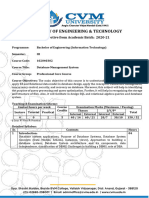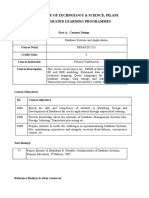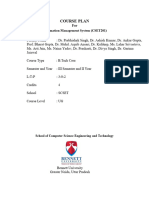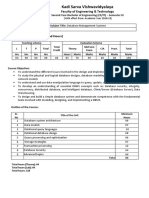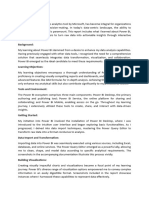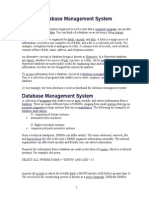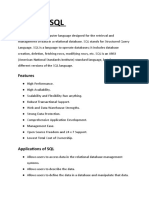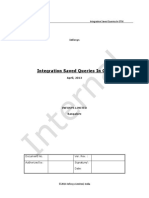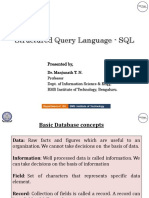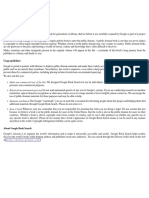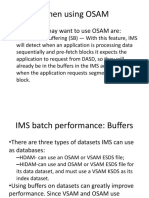8/17/25, 7:24 PM faculty.amizone.net/Academics/CourseCurriculumCDSRApprove/Index/?
CampusID=1&AcademicYear=2025-2026&CUID=9250FB…
Course Curriculum
Course Code: CSIT661 Credit Units L T P/S SW AS/DS FW No. of PSDA Total Credit Unit
Course Level PG 2 0 2 2 0 0 0 4
Course Title Relational Data Base Management System
Course Description The primary aim of the subject is to provide the students a deeper understanding of the relational database model by
: exposing them to a variety of important issues of data base management, e.g., database design, physical storage, query
optimization, database recovery, concurrency control, security and data integrity.
Course Objectives :
SN. Objectives
1 To provide the students a deeper understanding of the relational database system.
2 To expose them to a variety of important issues of relational data base management.
3 To aware them with database design, , query optimization, database recovery, concurrency control, security and data integrity.
Pre-Requisites : General
SN. Course Code Course Name
Course Contents / Syllabus :
SN. Module Descriptors / Topics Weightage
Introduction to DBMS; Architecture of DBMS; Components of DBMS; Traditional data Models
Module I: Introduction to
1 (Network; Hierarchical and Relational); Database Users; Database Languages; Schemas and 15.00
DBMS
Instances; Data Independence
Entity sets attributes and keys; Relationships (ER); Database modeling using entity; Weak and
Strong entity types; Enhanced entity-relationship (EER); Entity Relationship Diagram Design of an
2 Module II: Data Modeling E-R Database schema Object modeling; Specialization and generalization. Relational Database 20.00
Model: Basic Definitions; Properties of Relational Model; Keys; Constraints; Integrity rules;
Relational Algebra; Relational Calculus.
Module III: Relational Functional Dependencies; Normalization; Normal forms (1st, 2nd, 3rd, BCNF); Lossless
3 15.00
Database Design decomposition; Join dependencies; 4th& 5th Normal form; QBE
QL Components (DDL, DML, DCL); SQL Constructs (Select…from…where…. Group by…. Having….
Module IV: Query Order by…); Nested tables; Views; correlated query. PL/SQL: Introduction; Basic block; Structure of
4 15.00
Language PL/SQL program; Control Statements; Exception handling; Cursor Concept; Procedure; functions
and triggers.
Module V: Database
Basic security issues; Discretionary access control; Mandatory access control; Statistical database
5 Security and 10.00
security
Authorization
https://faculty.amizone.net/Academics/CourseCurriculumCDSRApprove/Index/?CampusID=1&AcademicYear=2025-2026&CUID=9250FB23-A47B-4E… 1/4
�8/17/25, 7:24 PM faculty.amizone.net/Academics/CourseCurriculumCDSRApprove/Index/?CampusID=1&AcademicYear=2025-2026&CUID=9250FB…
SN. Module Descriptors / Topics Weightage
Module VI : Transaction
Transaction concept; ACID properties; Schedules and recoverability; Serial and Non-serial
Management and
6 schedules; Serializability; Concurrency Problems; Concurrency Techniques: Locking Protocols, 15.00
Concurrency Control
Time stamping Protocol, Multi version Technique; Deadlock Concept – detection and resolution.
Techniques
Module VII: Backup and Database recovery techniques based on immediate and deferred update; ARIES recovery
7 10.00
Recovery algorithm; Shadow pages and Write-ahead Logging
Course Learning Outcomes :
SN. Course Learning Outcomes
Pedagogy for Course Delivery :
SN. Pedagogy Methods
Subject will be taught on the basis of blended mode which includes lectures as class room teaching, online mode of teaching, Case Study,
1 Lab practical’s by implementation of concepts related to database modeling and design using various real life situations. Online Flip mode
of teaching and developing E content for the students
Theory /VAC / Architecture Assessment (L,T & Self Work): 75.00 Max : 100
Attendance+CE+EE : 5+45+50
SN. Type Component Name Marks
1 Attendance 5.00
2 End Term Examination (OMR) 50.00
3 Internal MID TERM TEST 20.00
4 Internal HOME ASSIGNMENT 20.00
5 Internal VIVA VOCE 5.00
Lab/ Practical/ Studio/Arch. Studio/ Field Work Assessment : 25.00 Max : 100
Attendance+CE+EE : 5+45+50
SN. Type Component Name Marks
1 Attendance 5.00
2 External END TERM EXAMINATION 50.00
3 Internal CLASS TEST (PRACTICAL BASED) 20.00
4 Internal COMMUNICATION ASSESSMENT FILE 10.00
5 Internal CLASS PERFORMANCE 10.00
https://faculty.amizone.net/Academics/CourseCurriculumCDSRApprove/Index/?CampusID=1&AcademicYear=2025-2026&CUID=9250FB23-A47B-4E… 2/4
�8/17/25, 7:24 PM faculty.amizone.net/Academics/CourseCurriculumCDSRApprove/Index/?CampusID=1&AcademicYear=2025-2026&CUID=9250FB…
SN. Type Component Name Marks
6 Internal VIVA VOCE 5.00
Lab/ Practical details, if applicable :
SN. Lab / Practical Details
Create the following(s) table Salespeople with fields snum, sname, city, commission Orders table with fields onum, odate, snum, amt
1
Customers table with fields cnum, cname, city, rating, snum
2 Display name & city of salesman where city is “Pune
3 Display the numbers of sales persons, with orders currently in the orders table without any repeats.
4 Display all customers where city is ‘Mumbai’ rating is more than 100.
5 Display all customers where city is either ‘Pune’ or ‘Mumbai’
6 List all customers not having city ‘Pune’ or rating more than 100
7 Display all customers excluding those, with rating less than equal to 100, unless they are located in ‘Nagar’
8 Display all sales persons names starting with character ‘G’, the 4th character is ‘A’ & the rest of characters will be any.
9 Find all records from customers table where city is not known i.e. NULL.
10 Assume each salesperson has a 12% commission on order amt. Display orderno, snum, commission for that order.
11 Display the count of snum in order table without duplication of snum.
12 Display the counts of all orders for Feb05
13 Display the maximum outstanding amount as blnc+amt
14 Display details of orders order number & date wise
15 Display customers highest ratings in each city.
16 Write a query that totals the orders for each day & places the results in descending order.
17 Add a column current _bal in orders table for current balance
18 Increase commission of all sales persons by 200.
19 Display each order number followed by the name of customer who made it.
20 Calculate the amount of salespersons commissions on each order by a customer with a rating above 100.
21 Write a query that uses a sub-query to obtain all orders for the customer named ‘Gopal’.
22 Write a query that produces the names & ratings of all customers who have above-average orders
Create a union of two queries that shows the names, cities 7 ratings of all customers. Those with a rating of 200 or greater will also have
23
ratings “high rating”, while the others will have the words “low rating”.
Write a command that produces the name & number of each salesperson & each customer with more than one current order. Put results in
24
alphabetical order.
25 Create an index that would permit each salesperson to retrieve his or her orders grouped by date quickly.
26 Create a view that shows all of the customers who have highest ratings.
27 Create a view that shows number of salespeople in each city.
28 Write a PL/SQL program to update the commission of the sales person by 10% who are from Mumbai.
29 Write a PL/SQL program to create a view which is updatable.
30 Write a PL/SQL program to create a table from the existing table for salesperson who are earning commission more than 20000.
https://faculty.amizone.net/Academics/CourseCurriculumCDSRApprove/Index/?CampusID=1&AcademicYear=2025-2026&CUID=9250FB23-A47B-4E… 3/4
�8/17/25, 7:24 PM faculty.amizone.net/Academics/CourseCurriculumCDSRApprove/Index/?CampusID=1&AcademicYear=2025-2026&CUID=9250FB…
List of Professional skill development activities :
No.of PSDA : 0
SN. PSDA Point
Text & References :
SN. Type Title/Name Description ISBN/ URL
Elmasri & Navathe,” Fundamental of
1 Book Database Systems”, Pearson Education, 8131716252
Fifth Edition, 2009
Korth & Sudarshan,” Database System
2 Book 8131716252
Concepts”,TMH, Sixth Edition, 2010
C.J.Date,” An Introduction to Database
3 Book System”, Pearson Education, Eighth 0133004422
Edition, 2009
Bipin C Desai,” Introduction to Database
4 Book 8176560723
Systems”, Galgotia, Revised Edition, 2010.
Kevin Loney & Geroge Koch ,“Oracle 9i
5 Book :The Complete Reference”, TMH Edition 0072123621
2002
Ivan Bayross,” SQL,PL/SQL The
6 Book Programming Language Of Oracle”, BPB 8176560723
Publications,Third Revised Editio
Print
https://faculty.amizone.net/Academics/CourseCurriculumCDSRApprove/Index/?CampusID=1&AcademicYear=2025-2026&CUID=9250FB23-A47B-4E… 4/4

